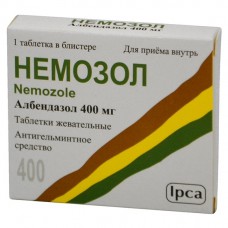Expiration date: 12/2026
Structure and Composition:
Tablets, film-coated.
1 tablet contains active substance: Albendazole 200 or 400 mg
Additional ingredients: corn starch, povidone, sodium lauryl sulfate methylparaben propylparaben gelatin 30 purified talc sodium starch glycolate, colloidal silicon dioxide, magnesium stearate
shell film
200 mg tablets: alcohol, hydroxypropyl methyl chloride * * titanium dioxide talc purified sodium lauryl sulfate, polyethylene glycol 400
400 mg tablets: * hydroxypropyl isopropyl alcohol, methylene chloride, propylene glycol, titanium dioxide *
* Organic solvents evaporate during drying.
Chewable Tablets.
1 tablet contains active substance: Albendazole 400 mg
Excipients: corn starch, sodium lauryl sulfate, povidone 30, methyl paraben, propyl paraben citric acid, gelatin, talc purified starch sodium glycolate colloidal silicon dioxide, magnesium stearate, aspartame flavor pineapple mint flavor
Oral suspension.
5 ml contains active substance: Albendazole 100 mg
Other ingredients: MCC sodium carboxymethylcellulose glycerin benzoic acid hydrochloride, potassium sorbic acid, polysorbate 80 solution of sorbitol essence mixed fruit flavor ice cream essence of purified water
Tablets 200 mg: PVC / aluminum foil blister 2 pcs. In the paper cartons 1 blister.
400 mg Tablets: in PVC / aluminum foil blister to 1 pc. In the paper cartons 1 blister.
Chewable Tablets: In blister PVC / aluminum foil 1 pc. In the paper cartons 1 blister.
Oral suspension: in plastic bottles with aluminum caps with navinchivayuschimesya PVC gaskets and rings the first opening, 20 ml in a cardboard bundle one bottle.
Description pharmaceutical form:
Tablets, film-coated: biconvex round shaped, film-coated white or almost white.
Chewable Tablets: lenticular, oval, kapsulovidnoy shaped, white or nearly white, with Valium on one party.
Oral suspension: suspension of white color.
Pharmacokinetics:
Poorly absorbed in the gastrointestinal tract, in unmodified form are not detected in the blood plasma, as rapidly converted in the liver to the primary metabolite - albendazole sulfoxide, also having anthelmintic activity. Oral bioavailability is low - about 30%. Eating fatty enhances absorption and Cmax (5 times). Tmax - 2-5 hours, 70% bound to plasma proteins and almost completely throughout the body is detected in urine, bile, hepatic, and cystic wall cyst fluid, cerebrospinal fluid.
Albendazole sulfoxide in the liver is converted into albendazole sulfone (secondary metabolite) and other oxygenated products. T1 / 2 albendazole sulfoxide -. 8.12 hours Return to form various metabolites in urine.
Renal excretion of albendazole and its primary metabolite, albendazole sulfoxide - a small, ground clearance is not changed in patients with impaired renal function.
Against the background of liver damage increases the bioavailability of the drug, Cmax albendazole sulfoxide increased by 2 times, T1 / 2 longer. Albendazole is an inducer of microsomal enzymes of the cytochrome P 450 accelerates the metabolism of many drugs.
Description of the pharmacological actions:
The main mechanism of action of albendazole - its inhibiting effect on the polymerization & beta-tubulin which leads to the degradation of cytoplasmic microtubules intestinal cells helminths changes the course of biochemical processes (inhibition of glucose utilization), blocks the movement of secretory granules and other organelles in muscle cells roundworms, causing their death . The most effective impact on the larval forms of cestodes - Echinococcus granulosus and Taenia solium, hookworms - Strongyloides stercolatis.
Testimony:
- nematodes (including ascariasis, enterobiosis, hookworm, necatoriasis, trichocephalosis)
- mixed worm infestation
- strongyloidiasis
- neurocysticercosis, caused by the larval form of the pork tapeworm (Taenia solium)
- hydatid disease of the liver, lung, peritoneum, caused by the larval form of the dog tapeworm Echinococcus granulosus, as an adjunct to surgical treatment of ehinokok cysts
- giardiasis
- toxocariasis.
Contraindications:
- idiosyncrasy, including other benzimidazole derivatives
- the retina of the eye
- pregnancy.
Precautions: in violation of blood, liver function (before and during treatment regularly check its function), breastfeeding.
Side effect:
Violation of the functions of the liver with a change in liver function tests (slight to moderate increase in transaminases), inhibition of bone marrow hematopoiesis (leukopenia, granulocytopenia, agranulocytosis, thrombocytopenia, pancytopenia), fever, abdominal pain, nausea, vomiting, headache, dizziness, meningeal symptoms, increased blood pressure, acute renal failure, reversible alopecia, skin rash, itching and other allergic reactions.
Drug Interactions:
Dexamethasone and cimetidine increase albendazole sulfoxide concentrations in the blood.
Dosage and administration:
Inside.
Take with meals. It is recommended that simultaneous treatment of all family members.
Standard dosage in the treatment of infestations with round worms for adults and children older than 2 years - 400 mg or 20 ml of the suspension inside once neurocysticercosis and hydatid disease: patients with 60 kg body weight or more - 400 mg 2 times a day, less than 60 kg - 15 mg / kg per day in 2 divided doses, the maximum daily dose - 800 mg * (2 tablets of 400 mg.). The course of treatment with neurocysticercosis - 8-30 days, echinococcosis - 3 cycles of 28 days with a 14-day break between cycles. When giardiasis in children - 10-15 mg / kg, 1 time a day for 5-7 days. When toxocarosis - adults and children over 14 years weighing more than 60 kg - 400 mg 2 times a day 7-14 days, less than 60 kg - 200 mg 2 times a day 7-14 days. Babies - 10 mg / kg two times a day 7-14 days.
* 200 mg dose tablets - no more than two per day.
Overdose:
Treatment: symptomatic gastric lavage, activated charcoal.
Precautionary measures:
In women of childbearing age before treatment is carried out in the absence of pregnancy test. During therapy required reliable contraception.
Patients neurocysticercosis should receive appropriate therapy with steroids, and anticonvulsants. Oral or / COP used to prevent hypertensive attack on the 1st week antitsistovoy therapy.
Recommended blood cell composition control in the event of leukopenia suspend therapy.
Blood tests should be carried out at the beginning of each 28-day cycle, and every 2 weeks during therapy albendazole. Continue treatment Albendazole is possible if the reduction of total white blood cells and leukocytes neyrotrofilnyh moderate and does not progress.




